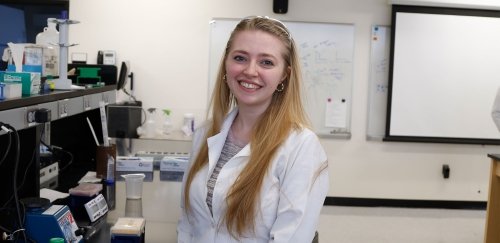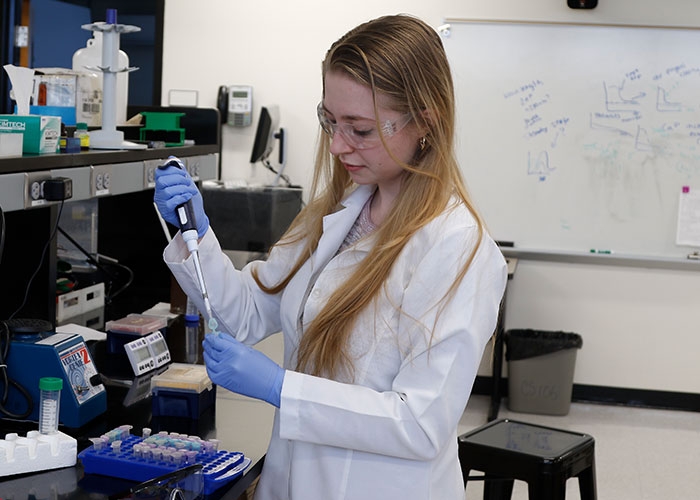MEET OUR GRADUATES: A Spinal Disorder Led to a Career in Medicine
- News & Events
- News
- MEET OUR GRADUATES: A Spinal Disorder Led to a Career in Medicine

“I think people heal others where they themselves hurt,” says Andrews, a chemistry major.
“My interest in medicine started when I was diagnosed at the age of 11 with a spinal disorder called idiopathic scoliosis. Scoliosis is a sideways curvature of the spine. Idiopathic means that no one knows what caused it,” says Morgan Andrews ’22.
Andrews’ spine is shaped like a reverse S. She wore a back brace from the age of 11 to 16. “Though I was insecure about my spine,” she says, “I was also super curious about it, too.”
She recalls how she would take every high school project and put a scoliosis spin on it. If it was a health project, she’d ask her teacher if she could make it a scoliosis project. In fine arts, she included a life-size ceramic replica of her back brace in her portfolio.
“I changed from feeling ashamed of my spine and being embarrassed to wear my back brace at sleepovers to being very proud of it,” she says. “The pride came from gaining more knowledge about scoliosis, the human anatomy and science in general. I realized it’s nothing to be ashamed of. It’s just a part of who I am.”
By age 16, Andrews became one of the lucky few whose spinal curvatures decreased in severity after wearing a back brace. “Only a small percentage of children with scoliosis improve the way I did,” she says. Though Andrews will always have two spinal curvatures, she no longer has to wear a back brace.

Andrews’ desire now is to become a physician scientist. She was first inspired by her own excellent doctors – the late Dr. Michael Ehrlich, who treated her from the age of 11 to 16; and Dr. Craig Eberson, who took over her care until she was 18.
“Dr. Ehrlich was a rock star, in my mind,” she says. “He was an exceptional orthopedic surgeon and researcher at Rhode Island Hospital. He was incredible at what he did and he dedicated his life to helping others. I would love to follow in that man’s footsteps, because he really altered my life. I hope to help others the way he helped me.”
Like Ehrlich, Andrews wants to be a physician and researcher. Her love of research was discovered when she worked in the biochemistry lab of RIC Professor Jamie Towle-Weicksel. Andrews gets a huge energy rush whenever she talks about that experience.
“I can’t thank Dr. Towle-Weicksel enough for the four years of teaching, training and support she gave me. I now know that not only do I want to treat patients, I want to work in a lab on innovative therapeutics for patients,” she says.
During her gap year, Andrews will continue her research at RIC while earning her EMT certification.
Reflecting back on her life, she says, “Scoliosis both literally and figuratively shaped who I am.” Her aunt, too, suffered from an orthopedic-related disorder. She was born with severe kyphoscoliosis with pulmonary complications and, as a child, was in and out of the hospital.
“Despite everything, she persevered,” says Andrews. “She was the first in the family to go to college; the first to get a job; and she’s the kindest, strongest person I know; she’s my biggest role model. There were so many obstacles in her way yet she overcame every barrier.”
Andrews intends to do the same as she enters the healing profession. “I think people heal others where they themselves hurt,” she says, with a smile.
